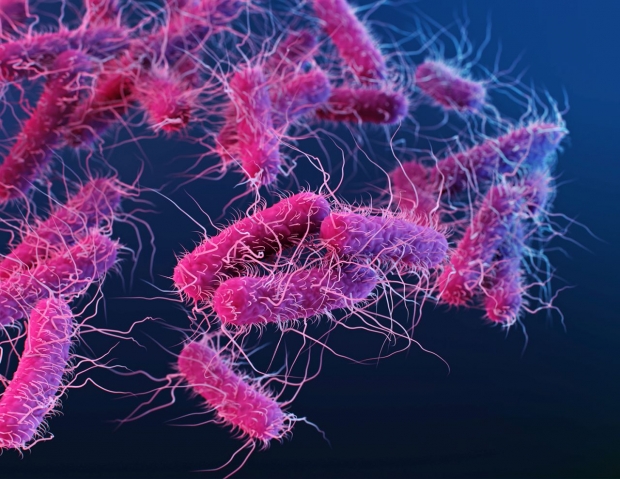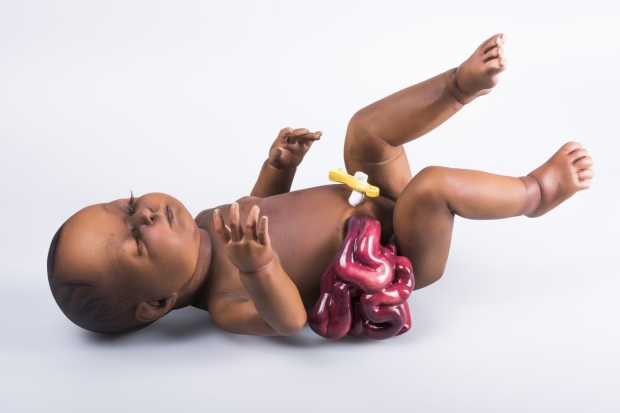Biomedical artist Alissa Eckert accurately illustrates the microscopic world through compelling 3D imagery, animation and motion graphics, helping communicate public health information and initiatives.
While infectious disease terminology like “Cryptosporidium” and “Campylobacter” is largely foreign to most individuals, it’s standard rhetoric among the medical illustration team at the Center for Disease Control (CDC). Collaborating with researchers and scientists, the five-person team develops compelling 3D imagery, animated videos, and motion graphics that convey health risks from parasites to bacteria, viruses, and more. From creating the ubiquitous 3D image of the COVID-19 coronavirus to developing an animated hearing loss video or designing a 3D printed model of a birth defect, the medical illustration team at the CDC delivers a range of visual communications that bring microscopic entities to life in the interest of public health.
The work of CDC artists has appeared in stories on major media outlets, including CNN, the New York Times, and many others. Most of the team’s projects originate as requests from scientists, researchers, and CDC staff. Each job varies in scope, size, and turnaround time, with some requiring animated deliverables, others large scale still renders or motion graphics. The team also creates comic-book style creative using toon rendering to communicate public health initiatives such as those around personal hygiene and hand washing. It is also part of a larger consolidated communication services unit at CDC that handles approximately 10,000 requests each year with the overarching objective of producing products that are equal to or better than what could be obtained commercially and providing a great customer experience.
Whatever the project, subject matter experts guide the illustration team through the creative process, providing scientific and medical input to ensure the utmost accuracy. Depending upon the project, the team will lean on a range of 3D content creation applications, including Autodesk 3ds Max for modeling, animation and VFX; Autodesk Arnold for rendering; the Adobe Creative Suite; Pixologic ZBrush for digital sculpting, Chimera for molecular modeling; and Daz 3D for figure modeling and rendering.
Computer-generated art with a mission
A Medical Illustrator with the CDC since 2006, Alissa Eckert is living out her dream job. “As a biomedical artist, I focus on impacting public health so I couldn’t think of anywhere else I’d rather work than CDC,” she shared. “If I wasn’t here, I might be at an animation studio, though I love knowing I can benefit people’s health, safety, and security.”
Eckert’s work often requires visualizing invisible threats in a way that promotes public awareness and understanding. “It’s important that materials be clear and concise, so there’s a fine balance between being true to science and taking artistic liberties to make the message easy to understand,” she explained. “Creating 3D content in 3ds Max, allows us to easily dial in information with clarity and precision, while rendering in Arnold helps ensure more realistic materials and lighting, resulting in a believable and accurate experience.”
Evolving design alongside scientific and technological innovation
While the majority of the animation done by Eckert and team is short form, such as GIFs or JPEGs intended for social media, they also tackle more time-intensive projects like the 2019 Antibiotic Resistance (AR) Threat Report, which took over a year to complete and required a lot of 3D work. To be able to create high-quality content quickly, Eckert stays apprised of the latest digital content creation tools and science behind the information she’s helping to communicate.
According to the artist, “Science and technology evolve so rapidly that we have to be able to adapt fast. We’re constantly exploring new learning techniques and programs to keep pace. We’ve moved from Photoshop drawings to 3D renderings, and more recently AR/VR and 3D printing.”
One of the bigger challenges Eckert and her team face every day is trying to create impressive work in an economical way, making workflow adjustments to accelerate render times, incorporate GPU resources, and create studio setups and libraries to share across the team. The team relies on 3ds Max and Arnold for many different applications, including animation, illustration, 3D printing, and even a few 360-degree prototypes. Using Arnold with 3ds Max 2020, the team has also been able to cut vector illustration times in half.
“The Arnold toon shader is useful for flat illustration designs and helps speed up the process of creating flat color designs that work well for instructional and public health information,” noted Eckert. “Working in 3D enables us to reproduce images at different angles or steps without having to redraw the entire image. We can just rotate the camera or animate the figure, and Arnold makes it all so easy. The active shade renderer helps tweak all our images quickly.”
Bringing invisible concepts to life with 3D printing
Eckert and her team also use 3ds Max to create models for 3D printing, whether for training materials for overseas public health work, lab materials or virus models. In 2019, Eckert created an award-winning 3D printed life size model of an infant with a birth defect of the abdominal wall called gastroschisis using 3ds Max. The model has been used to educate and train clinicians on proper measurement of the defect, leading to better care for infants with this condition.
3D printing has also been employed by the team to produce physical models of coronavirus, poliovirus, rotovirus, influenza, and E. coli. “After we build and optimize the models, we set the colors inside of 3ds Max then export them,” Eckert explained. “These models are used in many different functions. The flu models will be on display at the CDC museum for a hands-on approach to learning, while the polio models played a part in a live demonstration, and many others have been used for educational purposes at conferences and other lectures.”
Preparing for a yearlong CG-intensive project
While COVID-19 has demanded the majority of the team’s attention this year, a big focus of 2019 involved the creation of an updated Antibiotic Resistance Threats Report, a profile of all the deadliest bacteria and their current states of urgency. A yearlong project that began in January, it would require the team to create 3D medical imagery of each bacteria for both dark and light backgrounds and in many different formats and sizes for use across platforms and in various contexts. For example, a visualization of the gonorrhea bacterium needed to be 3D printed in large format for display at the 2019 United Nations General Assembly held in September.
The 2019 AR Threats Report was a follow up to a 2013 project that most of the current CDC medical illustration had also worked on. While that report was viewed as widely successful and had been disseminated throughout the world, the information needed to be updated, which provided the team an opportunity to bring new life and ideas to original visuals. As production lead, Eckert outlined the technical aspects for the new project and developed the overall aesthetic, opting for a theme of “Beautiful but Deadly” to captivate the view with striking artwork while also convey the seriousness of antibiotic resistance.
Behind-the-scenes of the creative process
“Throughout the process of creating the bacteria, we had several meetings to discuss the project’s design and direction,” Eckert described. “I created a studio template in 3ds Max with specific cameras, lights and backdrops dialed into it. Underwater jellyfish and other bright beautiful creatures inspired our look, and the transmission settings in the material helped us emulate jellyfish texture for the bacteria images. Drawing from something that exists in nature aided us in creating a piece that seems lifelike and believable. We were able to enhance the bacterium’s characteristics, such as its behavior and the way it moves or colonizes, or its textures, or lighting to help create the illusion of something you feel as though you could reach out and touch.”
As a unified basis, Eckert set size dimensions in 3ds Max to fit the character profiles, with the right and bottom sides open, and also created specific settings in the materials, which were pink and purple to represent gram positive and gram-negative stain colors. From there, each artist could fine tune the image, such as adjusting depth of the transmission depending on whether their model was thicker, or tweaking the lights based on their setup. While Eckert created these templates, her team lead created physics simulations to run through particle flow or cloth simulations to create realistic interactions among the objects. Artists modeled each bacterium at a set scale, ran that model through a simulation, and found a frame and location of the simulation they desired. They then collapsed the animated frame of the simulation and brought that into the studio setup.
During reviews, the entire team convened, printed all the images, and pinned them to the walls around them. They also visualized them on the computer screen to ensure the images were consistent, then made adjustments as needed. Files were rendered as EXRs with AOVs, such as Z-depth, which allowed the team to quickly work with 3D channel effects like depth of field of 3D fog in After Effects. This approach lowered render times and allowed for on-the-fly adjustments that were needed for different layouts.
“Our biggest challenge was ensuring that all our designs would work in these various outputs while maintaining a consistency of visual aesthetic. We ran tests to ensure certain colors would stay pure and print well while appearing dynamic on screen. I’m really proud of the 2019 AR Threats Report project and it’s been extremely successful, even though it launched only a few months prior to the COVID-19 pandemic,” Eckert shared.
Charting a path forward
In closing, Eckert said, “Though COVID-19 remains our priority for the time being, I look forward to further advancing our workflow. We’ve been training with real-time game engines and how to integrate AR/VR with 3ds Max, as well as scripts for animation projects that we want to execute once we have the time.”
Dan Sarto is Publisher and Editor-in-Chief of Animation World Network.













